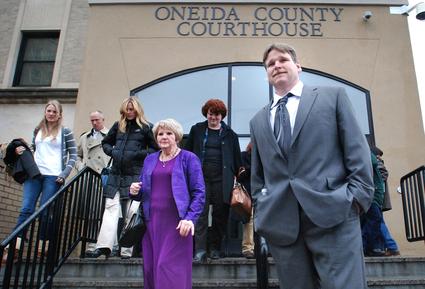Improper Forensics and Two Decades in Prison
01.08.10

In 1989, Steven Barnes was convicted of the rape and murder of 16-year-old Kimberly Simon in Utica, New York. The prosecution's case against Barnes was based in part on unvalidated and improper forensic science. After serving almost two decades in prison, Barnes was officially exonerated one year ago this week
Today, Barnes works helps oversee a youth program for his county's workforce development office and recently moved into his own apartment. He frequently speaks to community groups and policymakers about the importance of addressing the causes of wrongful conviction to prevent injustice.
Faulty forensics were a central cause of Barnes' wrongful conviction. Three types of forensic evidence were used against Barnes: fabric print analysis, soil comparison, and microscopic hair analysis. None of these three techniques has been proven in empirical studies to be reliable and aspects of this evidence clearly misled the jury in Barnes' case.
The fabric print analysis allegedly linked the victim's unusual jeans to a dust print on the outside of Barnes' truck, but the methods used to determine a link were unproven and unreliable. Soil from Barnes truck was chemically compared to soil at the crime scene, but technicians didn't offer an analysis of whether the soil in either sample was particularly unique.
Testimony regarding microscopic hair comparisons in particular can mislead juries to believe that a similarly is actually a "match." According to a report released in 2009 by the National Academy of Sciences (NAS), "No scientifically accepted statistics exist about the frequency with which particular characteristics of hair are distributed in the population. There appears to be no uniform standards on the number of features on which hairs must agree before an examiner may declare a 'match.'" Nearly one in five wrongful convictions overturned through DNA testing involved faulty hair analysis.
Despite the groundbreaking recent NAS report on forensic science, there remains a grievous lack of oversight of crime labs across the country. Moreover, methodologies and standards vary by examiner. Countless innocent people have been sent to prison in the U.S. based on faulty forensics while the real perpetrators of crimes remain free. In response, the Innocence Project, spearheading the Just Science Coalition, has developed a plan for reform that includes the creation of a national Office of Forensic Science Improvement and Support (OFSIS). OFSIS, with input from law enforcement, prosecutors, crime laboratories, the judiciary and the defense bar, will support research in forensics practices, set mandatory accreditation and certification standards and ensure compliance with those standards.
These reforms are critical to prevent future injustices like the one endured by Steven Barnes.
Learn more about federal forensic reforms and take action here
.
Other Exoneree Anniversaries This Week:
Mark Diaz Bravo
, California (Served 3 Years, Exonerated 1/6/94)
David Vasquez
, Virginia (Served 4 Years, Exonerated 1/4/89)
Larry Holdren
, West Virginia (Served 15 Years, Exonerated 1/4/00)

Leave a Reply
Thank you for visiting us. You can learn more about how we consider cases here. Please avoid sharing any personal information in the comments below and join us in making this a hate-speech free and safe space for everyone.